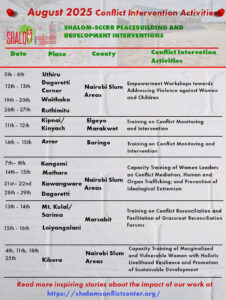By Francis Mwangi

Shalom working with local community leaders to transform conflict and build peace.
Years of peacebuilding in conflict environments of Northern Kenya, Nairobi and Nakuru provide both success and challenges. These are renowned hotbeds for conflicts linked to ethnic identities, animosity, cultural differences, resource competition, institutional neglect, state weakness and political interests just to mention a few key ones. Shalom has encountered all in researching these conflicts and being at the center of resolving and transforming them for a number of years.
In its work, Shalom inserts itself into the conflict terrains for prolonged periods, responding proactively and creatively with its qualified personnel to settings of deep socio-economic and institutional related conflicts by engaging in initiatives that generate conflict transformation and promote endurable peace.
People often ask how you measure success in peacebuilding. Unquestionably, the metrics of development projects are easier to measure because they are quantifiable and concretely easier to observe. To measure success Shalom is guided by various indicators that point to conflict reduction; conflict prevention; conflict transformation; and ultimately existence of sustainable peace.
Shalom has established indicators of success alternatively used as metrics for measuring results in regard to its peacebuilding work. Here are some of the key areas of focus:
- Individuals and communities increased knowledge, skills and techniques in resolving and transforming conflicts;
- Change of perceptions and attitudes leading to transformation of intractable conflicts;
- Communities empowered with high quality advocacy skills-techniques to be architects of their own road map to peace and development; resolution from the bottom up
- Dialogue and consultation for peace among conflicting groups and relevant stakeholders; enabling them to sit at the table of peace and negotiation
- Communities opting for non-violent dispute settlement systems;
- Target groups and individuals engaging in concrete initiatives that contribute to peace between the conflicting ethnic communities.
- Improved relationships between ethnic communities as expressed in common sharing of activities, and resources such as pasture.
- Former warring groups engaging in interethnic sharing of schools, medical centers and market places;
- Pupils increased tolerance of the ‘ethnic other’ with special focus on inter-ethnic schools
- Women increased participation in intra and inter-ethnic conflict resolution and transformation initiatives
- Moving through Inter-religious dialogue to cooperative project implementation for peace and development; from talking the talk to walking the walk; idealism to lived reality!
- SCCRR policy advocacy work in partnership with regional, state and national, civic and faith-based organisations;
- Working with local and county leadership to apply more professional and participatory approaches in conflict resolution and transformation;
- Increased awareness by institutions, local leaders and the target community of the root causes of conflicts, informed by empirical research, as distinct from just trigger and proximate causes;
- Shalom’s empirical academic research role of influencing public policy at grassroot, county, national and regional levels-IGAD
- School children accessing SHALOM’s Peace Syllabus and greater comprehensive education – through SHALOM’s schools support program in Eastern Africa;
The qualitative nature of indicators reflects how measuring peacebuilding results/outcomes has less to do with numbers as could be the case for development projects. Peacebuilding indicators seek to measure an aspect of human life which is not determined through quantification. Understandably peacebuilding interventions involves change that is more intangible than concrete thus the challenge to quantify.

Meeting with communities and creating action plans for peace is central to Shalom’s intervention
More than using the indicators, (to measure outcomes and impact) Shalom measures its peace and development approach strategy through some notable outputs.
To date, Shalom has managed to equip more than 5,300 key and influential opinion shapers with knowledge and skills key in conflict prevention, management and transformation in Northern Kenya Counties: Turkana, Marsabit, Samburu, and West Pokot. Furthermore, we have focused on conflict environments in major urban centers such as, Kitale, Eldoret, Nairobi and Nakuru Counties.
In the effort of promoting education for peace and development in conflict environments, Shalom has built/rehabilitated over 20 inter-ethnic schools in Northern Kenya, supplied: 125 schools with Solar lighting units, chairs and classroom tables – reaching more than 25,000 pupils. Shalom has supported peace education through the development of Peace Syllabus subsequently producing peace manuals for schools especially in the Northern Kenya. To support communities in conflict environments with healthcare, we have offered assistance to clinics, nutrition and AIDS programmes.
To influence and address conflicts at the leadership level, we have trained District Peace Commitees (DPC’s), police, chiefs and religious leaders on peacebuilding skills. The statistics from our records show that, of those trained 58% are men and 42% women. Analyzing trainee representation over years of our work, there is statistical remarkable increase of women in peacebuilding.

SCCRR training police officers to have the skills of conflict analysis in their work.
A key point of leverage going forward is our partnerships with key institutions such as IGAD (Intergovernmental Authority on Development – comprised of eight countries in the Horn of Africa); Shalom Staff offering courses on Peace Studies at Tangaza University College Nairobi, and Institute of Peace and International Relations, Hekima, Nairobi.
The outputs are not measures of success, but necessary pre-conditions for project outcomes and impact. Acknowledging the challenge of achieving results in peacebuilding, Shalom continues to overcome them through inserting itself into the conflict environments, walking with the communities searching for peace and development, applying resources, i.e, analyzing the conflict through empirical research and approaching it constructively and professionally.

